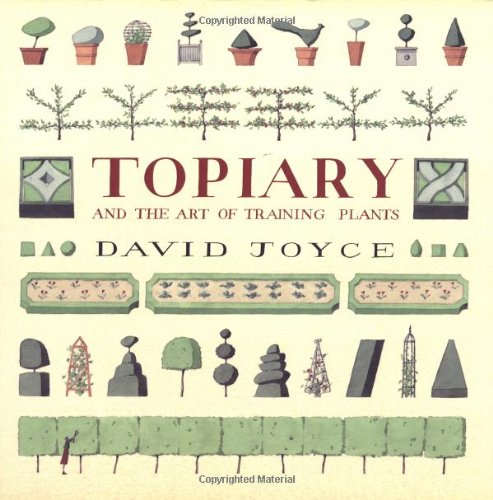Topiary and the Art of Training Plants - Hardcover

"synopsis" may belong to another edition of this title.
Excerpted from the Introduction
In praise of trimmed plants
The fashionable revival of interest in topiary and other components of formal gardens allows us to see what have always been their strong points. One of these is weight. Topiary and hedges give a reassuring impression of established order and permanence in the garden that is difficult to achieve in any other way, except by stone and brick masonry. An assembly of formal components can create a garden of calm solemnity; and topiary and hedges also combine well with the more ephemeral effects of color and texture. Living sculpture and architecture have their own seasonal changes, an attractive moment being when new growth threatens to obscure clipped shapes But at its best the year-round framework of green needs no floral titillation in spring and summer to give it value. And, if the layout has been thoughtfully designed, green architecture works well with real architecture, extending the lines of buildings and completing vistas
In this respect formal gardens show remarkable adaptability. In the past they have often been seen as mediating between the house and the landscape beyond, whether looking out on an Italian view of hills and valleys or, in a grand French garden, framing perspectives that seem to extend to infinity; but the reality for many gardeners is that the best chance of making something worthwhile of a small to medium-size urban plot is to avoid making connections with the world beyond. To do this, a self-contained design is needed, its internal structure working even when it is fully enclosed. Hedges and other living screens of the formal garden create the shelter and privacy that make a little paradise possible, and topiary or patterned planting can ensure that the garden has a satisfying internal dynamic. The combination of hedged compartments and topiary can provide the basis for some of the simplest and most pleasing designs for small gardens, while container-grown topiary and trained plants are versatile garden components for paved yards or patios and balconies.
Gardeners who have never attempted topiary often feel that mysterious and labor-intensive techniques are involved in forming a shape that may take many years to reach maturity. This is not so. The only really essential requirement is a little self-confidence. The few techniques involved are simple and within the competence of inexperienced gardeners. The plants most commonly used are remarkably tough, and with good sharp tools all the clipping is light easy work. Furthermore, topiary is not time-consuming to look after. In the formative stages and even when the shapes are mature, simple cones and pyramids under 6ft (1.8m) high can normally be clipped in five minutes or less. A satisfying small-scale shape can be achieved in a few years. And almost everyone who has trained and maintained topiary speaks of the formative pruning and subsequent clipping as a pleasurable and highly satisfying activity.
Hedges, knots and embroidered patterns are inevitably more time-consuming to look after. They are not intrinsically difficult to lay out and, provided the plants used are slow-growing-such as boxwood (Buxus sempervirens) and yew (Taxus baccata) -- there is only one major burst of activity a year. With powered hedge-trimmers even long hedges can be clipped quite quickly, but the maintenance should be planned before planting on a grand scale. Working from ladders and platforms or trimming detailing of any kind add considerably to the time it takes to cut hedges.
The important thing is to be aware of how much effort is required for each technique and attempt only those that suit you. Whether you try a boxwood cone or a yew tunnel, the potential rewards are considerable. Gardeners of different tastes find in topiary, and in the use of hedges and patterned planting, a way of creating something of marked individuality, even when the formula has been used so often before. Countless variations are possible in the arrangement of geometric shapes and in the weave and flow of patterns. For many gardeners, however, the great delight of topiary is the possibility of expressing their own lighthearted fantasies in a sympathetic, easily worked medium. The models of the past remain a major source of inspiration for gardens today, but the scope for innovation in the treatment of space and juxtaposition of familiar and unfamiliar abstract shapes gives topiary and the use of hedges and patterned planting an exciting future.
"About this title" may belong to another edition of this title.
- PublisherFrances Lincoln
- Publication date1999
- ISBN 10 0711211574
- ISBN 13 9780711211575
- BindingHardcover
- Edition number1
- Number of pages160
- Rating
Buy New
Learn more about this copy
Shipping:
US$ 10.74
From Italy to U.S.A.
Top Search Results from the AbeBooks Marketplace
Topiary and the Art of Training Plants. Illustrations by Laura Stoddart
Book Description Rilegato. Condition: nuovo. New. Ships euro 10.50 in Europe, UK included. World 11.50. Your second copy NO extra shipping! Italy: local postal tariffs. Jacket slightly discoloured at right border. Directory. Index. David Joyce is a celebrated garden writer and planting advisor, and expert in the techniques of pruning and training plants. He also wrote the best-selling book: The Ultimate Container Garden., Ill. bn: 60 drawings, Ill. colori: 120 colour ilustrations, Peso: 995 gr. Seller Inventory # 1882-CC19
TOPIARY AND THE ART OF TRAINING
Book Description Condition: New. New. In shrink wrap. Looks like an interesting title! 2.2. Seller Inventory # Q-0711211574

